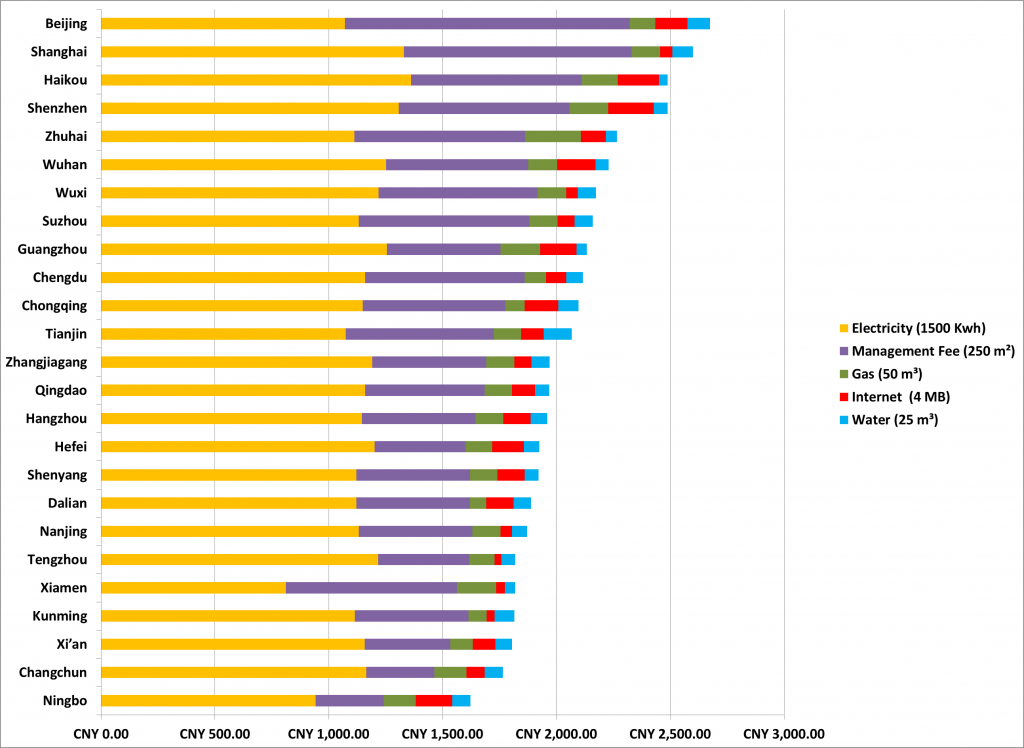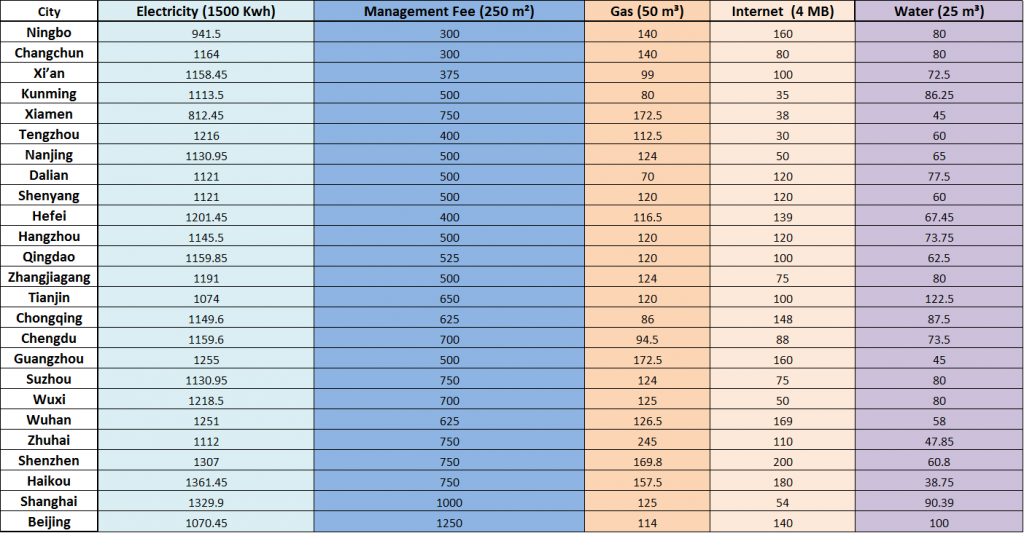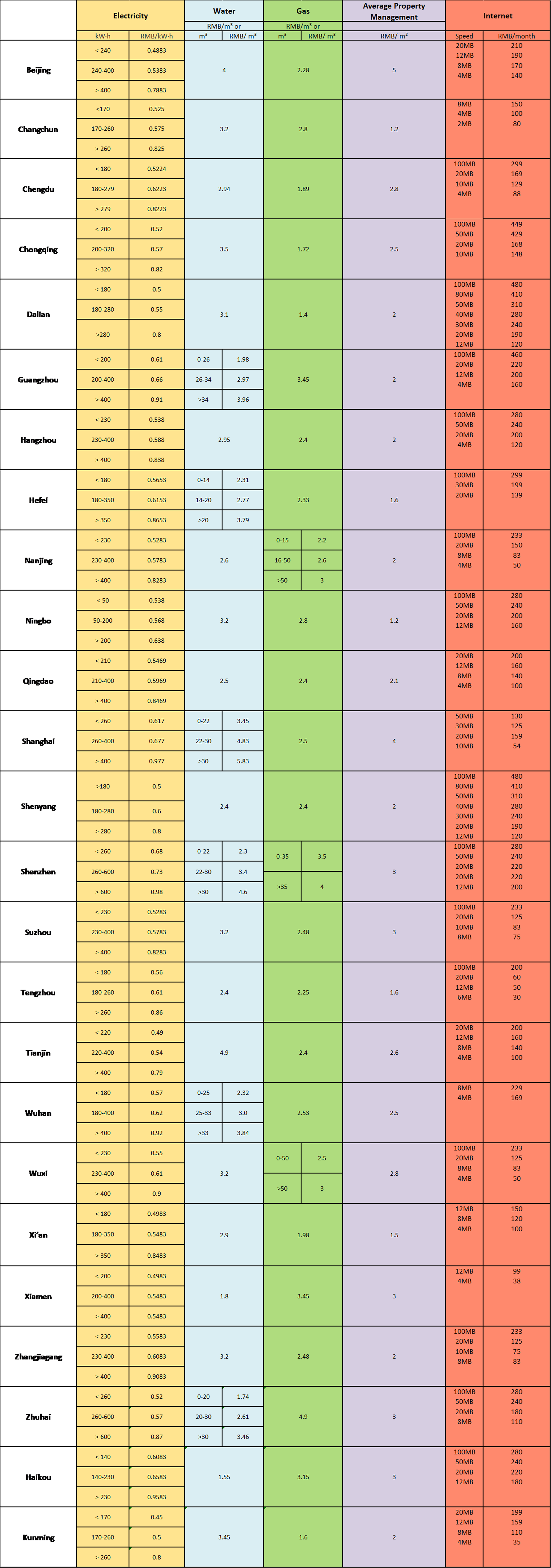Utility Costs in Secondier China Cities
- Details
- Category: Ningbo News
- Published: Friday, 28 November 2014 13:53
ON AUGUST 1 | IN BEIJING, CHANGCHUN, CHANGSHA, CHENGDU, CHONGQING, DALIAN, GLOBAL INFORMATION, GUANGZHOU, HANGZHOU, HEFEI,HEIFEI, NANJING, NINGBO, QINGDAO, SANYA, SHANGHAI, SHENYANG, SHENZHEN, SUZHOU, TIANJIN, WUHAN, WUXI, XI'AN, XIAMEN, ZHANGJIAGANG,ZHUHAI | BY MAXXELLI | WITH NO COMMENTS
In this 2nd Tier Insight, we conducted an analysis on the average cost of utilities in different cities across China. We hope you find the data useful in predicting the average living cost in the areas we included.  *Our data was collected using stats for an average family of four per month, analysing the cost of; electricity (1500 Kwh), gas (50 m³), water (25 m³), internet (4 MB) and the management fees for accommodation.
*Our data was collected using stats for an average family of four per month, analysing the cost of; electricity (1500 Kwh), gas (50 m³), water (25 m³), internet (4 MB) and the management fees for accommodation.  Quite predictably, the two most expensive cities to live in, according to our research, were Beijing and Shanghai. In fact, our results suggested that it costs over RMB 1000 more, per month, to live in Beijing than Ningbo. While electricity in Beijing is relatively cheap, RMB 1070 per 1500 Kwh, the management fees for accomodation are significantly higher than any other of our analysed cities; costing RMB 1250 per 250 m².
Quite predictably, the two most expensive cities to live in, according to our research, were Beijing and Shanghai. In fact, our results suggested that it costs over RMB 1000 more, per month, to live in Beijing than Ningbo. While electricity in Beijing is relatively cheap, RMB 1070 per 1500 Kwh, the management fees for accomodation are significantly higher than any other of our analysed cities; costing RMB 1250 per 250 m².
Some results, however, were quite surprising. Haikou, for example, the scenic capital of the island province Hainan, had a higher overall cost than established first-tier cities like Shenzhen and Guangzhou. Haikou’s electricity costs were the clinching factor in this result – in fact, Haikous’s electricity at RMB 1361.45 per 1500 Kwh was the most expensive of all our cities, the second being Shanghai at RMB 1329.90. Cost of living in Haikou is unfortunately likely to continue rising as more and more people continue to be attracted to the area. It is a beautiful city, the second least polluted in China, and, due to it’s geographical position next to South East Asia, has a thriving commerce industry.
Behind Shenzhen, in fourth place, was Zhuhai, located on the southernmost tip of Guangdong, bordering Macau. While the two most expensive costs, electricity and management fees were relatively cheap in Zhuhai, it’s gas prices were through the roof, costing 245 m³!
The results from prominent second tier cities like Chengdu, Chongqing and Qingdao were moderate; around RMB 2000 per month. The cost of electricity for these cities was almost identical, however Chengdu’s management fees were slightly higher, reflecting the increasing development of the city that is driving up living costs in the area. Chongqing’s management costs were in the mid-range of our results, largely attributable to the explosion of retail and housing development in the last century. This surplus allows the city to keep retail rental costs down, enticing further FDI to the area.
The cheapest areas of our analysis, Xi’an, Changchun and Ningbo, have high potential for further development. Despite, per capita income being low in these areas, keeping living costs down, the industries of these areas are highly important; Xi’an now has one of the country’s most important aerospace research institutes; Changchun has the largest automobile trade zone in China; and Ningbo has one of China’s largest trading ports, second only to Shanghai!![]()
The table below gives a complete overview of utility cost in China:
Source http://maxxelli-blog.com/2014/08/2nd-tier-insights-utility-cost/








